Passengers 163 Fatalities 101 Date 29 December 1972 Survivor 75 (77 initially) Injuries (nonfatal) 75 | Crew 13 Survivors 75 (77 initially) Number of deaths 101 Passenger count 163 | |
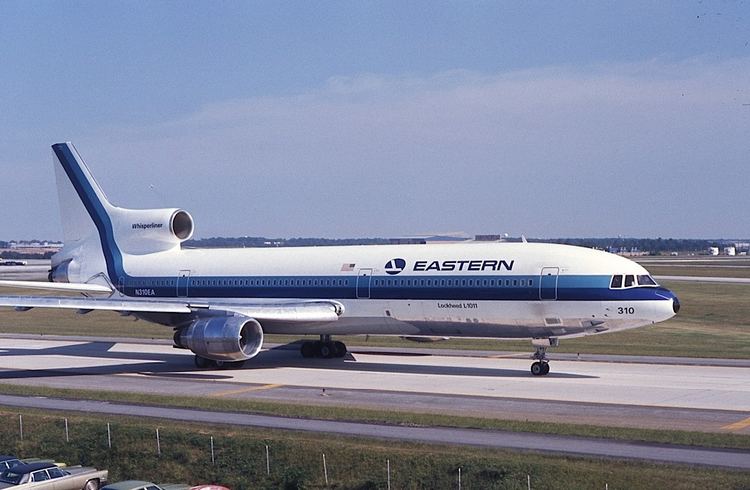 | ||
Summary Pilot error;controlled flight into terrain Site Florida EvergladesMiami-Dade County, FloridaUnited States Similar Birgenair Flight 301, American Airlines Flight 96, British European Airways F, Southern Airways Flight 242, Partnair Flight 394 | ||
Eastern Air Lines Flight 401 was a Lockheed L-1011-1 Tristar jet that crashed into the Florida Everglades at 11:42 pm December 29, 1972, causing 101 fatalities (99 initial crash fatalities, two died shortly afterward). The captain, along with one of two flight crew members, two of 10 flight attendants, and 97 of 163 passengers, died; 75 passengers and crew survived. The crash occurred as a result of the entire flight crew becoming preoccupied with a burnt-out landing gear indicator light, and failing to notice the autopilot had inadvertently been disconnected. As a result, while the flight crew was distracted with the indicator problem, the aircraft gradually lost altitude and crashed. It was the first crash of a widebody aircraft and at the time, the second-deadliest single-aircraft disaster in the United States.
Contents
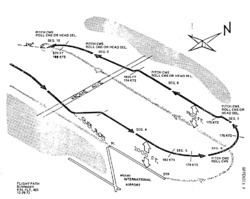
Aircraft
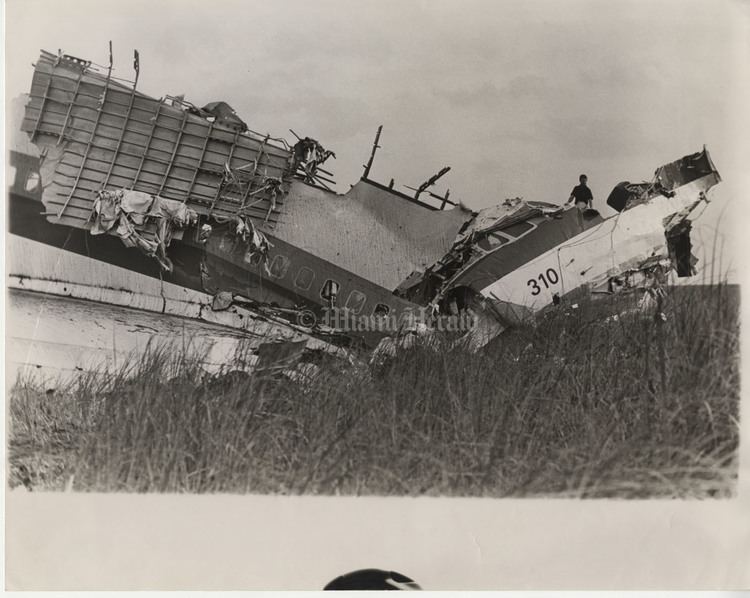
Eastern Air Lines Flight 401 was a regularly scheduled flight from John F. Kennedy International Airport in Queens, New York, to Miami International Airport in Miami, Florida. On the day of the crash, Flight 401 was operated using a four-month-old Lockheed L-1011-1 TriStar (registration N310EA,), which had been delivered to the airline on August 18, 1972. The aircraft was number 310 in Eastern's fleet, and the tenth Tristar delivered to the carrier.
Flight crew
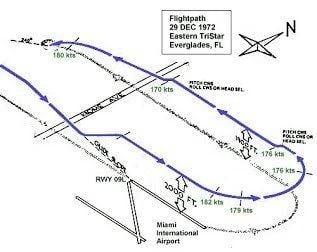
The flight was under the command of Captain Robert Albin 'Bob' Loft, 55, a veteran pilot ranked 50th in seniority at Eastern. Captain Loft had been with the airline for 32 years and had accumulated a total of 29,700 flight hours throughout his flying career. He had logged 280 hours in the L-1011. His flight crew included First Officer Albert John Stockstill, 39, who had 5,800 hours of flying experience, and Second Officer (flight engineer) Donald Louis 'Don' Repo, 51, who had 15,700 hours of flying experience. A company employee—technical officer, Angelo Donadeo, 47, returning to Miami from an assignment in New York—accompanied the flight crew for the journey, but was officially an off-duty "non-revenue passenger".
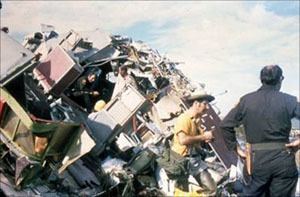
The ten-woman flight attendant crew on Flight 401 included: Mercedes Ruiz, Sue Tebbs, Adrienne Hamilton (lead flight attendant), Trudy Smith, Dorothy Warnock, Patricia Ghyssels, Beverly Jean Raposa, Patricia 'Patty' Georgia, Stephanie Stanich, and Sharon Transue. Pat Ghyssels (seated on jumpseat 3L) and Stephanie Stanich (seated on jumpseat 4L) died in the crash.
The crash
Flight 401 departed JFK Airport on Friday, December 29, 1972, at 21:20 Eastern Standard Time, carrying 163 passengers and 13 crew members on board.
The flight was routine until 23:32, when the plane began its approach into Miami International Airport. After lowering the gear, Stockstill noticed that the landing gear indicator, a green light identifying that the nose gear is properly locked in the "down" position, had not illuminated. This was later discovered to be due to a burned-out light bulb. The landing gear could have been manually lowered nonetheless. The pilots cycled the landing gear, but still failed to get the confirmation light.
Loft, who was working the radio during this leg of the flight, told the tower that they would discontinue their approach to their airport and requested to enter a holding pattern. The approach controller cleared the flight to climb to 2,000 feet (610 m), and then hold west over the Everglades.
The cockpit crew removed the light assembly, and Second Officer Repo was dispatched to the avionics bay beneath the flight deck to confirm via a small porthole if the landing gear was indeed down. Fifty seconds after reaching their assigned altitude, Captain Loft instructed First Officer Stockstill to put the L-1011 on autopilot. For the next 80 seconds, the plane maintained level flight. Then, it dropped 100 feet (30 m), and then again flew level for two more minutes, after which it began a descent so gradual it could not be perceived by the crew. In the next 70 seconds, the plane lost only 250 feet (76 m), but this was enough to trigger the altitude warning C-chord chime located under the engineer's workstation. The engineer (Repo) had gone below, and no indication was heard of the pilot's voices recorded on the CVR that they heard the chime. In another 50 seconds, the plane was at half its assigned altitude.
As Stockstill started another turn, onto 180°, he noticed the discrepancy. The following conversation was recovered from the flight voice recorder later:
Less than 10 seconds after this exchange, the jetliner crashed. The location was west-northwest of Miami, 18.7 miles (30.1 km) from the end of runway Nine Left (9L). The plane was traveling at 227 miles per hour (365 km/h) when it hit the ground. With the aircraft in midturn, the left wingtip hit the surface first, then the left engine and the left landing gear, making three trails through the sawgrass, each 5 ft wide and more than 100 feet (30 m) long. When the main part of the fuselage hit the ground, it continued to move through the grass and water, breaking up as it went.
Rescue and aftermath
Robert "Bud" Marquis, an airboat pilot, was out frog gigging with Ray Dickinsin when they witnessed the crash. They rushed to rescue survivors. Marquis received burns to his face, arms, and legs—a result of spilled jet fuel from the crashed TriStar—but continued shuttling people in and out of the crash site that night and the next day. For his efforts, he received the Humanitarian Award from the National Air Disaster Alliance/Foundation and the "Alumitec – Airboat Hero Award", from the American Airboat Search and Rescue Association.
In all, 77 survived the ordeal—69 of the 163 passengers and eight of the 10 flight attendants survived the crash, with 99 initial fatalities. Despite their own injuries, the surviving flight attendants were credited for helping other survivors and several quick-thinking actions such as warning survivors of the danger of striking matches due to jet fuel in the swamp water and singing Christmas carols to keep up hope and draw the rescue teams' attention, as flashlights were not part of the standard equipment on commercial airliners at the time. Of the cockpit crew, only flight engineer Repo survived the initial crash, along with technical officer Donadeo, who was down in the nose electronics bay with Repo at the moment of impact. Stockstill was killed on impact, while Captain Loft died in the wreckage of the flightdeck before he could be transported to a hospital. Repo was evacuated to a hospital, but later succumbed to his injuries. Donadeo, the lone survivor of the four flightdeck occupants, recovered from his injuries. Donadeo passed away in 2004, aged 79.
Most of the dead were passengers in the aircraft's midsection. The swamp absorbed much of the energy of the crash, lessening the impact on the aircraft. The mud of the Everglades may have blocked wounds sustained by survivors, preventing them from bleeding to death. However, it also complicated the survivors' recuperation, as organisms in the swamp caused infection, with the potential for gas gangrene. Eight passengers became infected; doctors used hyperbaric chambers to treat the infections. All the survivors were injured; 60 received serious injuries and 17 suffered minor injuries that did not require hospitalization. The most common injuries were: fractures of ribs, spines, pelvises, and lower extremities. Fourteen survivors had various degrees of burns.
Cause of the crash
The National Transportation Safety Board (NTSB) investigated the accident.
The NTSB investigation discovered that the autopilot had been inadvertently switched from altitude hold to control wheel steering (CWS) mode in pitch. In this mode, once the pilot releases pressure on the yoke (control column), the autopilot maintains the pitch attitude selected by the pilot until he moves the yoke again. Investigators believe the autopilot switched modes when the captain accidentally leaned against the yoke while turning to speak to the flight engineer, who was sitting behind and to the right of him. The slight forward pressure on the stick would have caused the aircraft to enter a slow descent, maintained by the CWS system.
Investigation into the aircraft's autopilot showed that the force required to switch to CWS mode was different between the A and B channels (15 vs. 20 lb or 6.8 vs. 9.1 kg, respectively). Thus, the switching to CWS in channel A possibly did not occur in channel B, thus depriving the first officer of any indication the mode had changed (Channel A provides the captain's instruments with data, while channel B provides the first officer's).
After descending 250 feet (76 m) from the selected altitude of 2,000 feet (610 m), a C-chord sounded from the rear speaker. This altitude alert, designed to warn the pilots of an inadvertent deviation from the selected altitude, went unnoticed by the fatigued and frustrated crew. Investigators believe this was due to the crew being distracted by the nose gear light, and because the flight engineer was not in his seat when it sounded, so would not have been able to hear it. Visually, since it was nighttime and the aircraft was flying over the darkened terrain of the Everglades, no ground lights or other visual sign indicated the TriStar was slowly descending.
Captain Loft was later found to have an undetected tumor in his brain, and this was later found to be in an area controlling vision. However, the NTSB concluded that the captain's tumor did not contribute to the accident.
The final NTSB report cited the cause of the crash as pilot error, specifically: "the failure of the flight crew to monitor the flight instruments during the final four minutes of flight, and to detect an unexpected descent soon enough to prevent impact with the ground. Preoccupation with a malfunction of the nose landing gear position indicating system distracted the crew's attention from the instruments and allowed the descent to go unnoticed."
In response to the accident, many airlines started crew resource management training for their pilots. The training is designed to make problem solving in a cockpit much more efficient, thus causing less distraction for the crew. Flashlights are now standard equipment near jumpseats and all jumpseats are outfitted with shoulder harnesses.
In popular culture
The story of the crash and its aftermath was documented first in John G. Fuller's 1976 book The Ghost of Flight 401, which argued that paranormal events were caused by the salvaged wreckage of the aircraft. Eastern Air Lines CEO (and former Apollo astronaut) Frank Borman called the ghost stories surrounding the crash "garbage". Eastern considered suing for libel, based on assertions of a cover-up by Eastern executives, but Borman opted not to, feeling a lawsuit would merely provide more publicity for the book. Loft's widow and children did sue Fuller, for infringement of Loft's right of publicity, for invasion of privacy, and for intentional infliction of emotional distress, but the lawsuit was dismissed and the dismissal upheld by the Florida Fourth District Court of Appeal. All parts that were cannibalized from flight 401’s frame were eventually removed from other Eastern Airlines aircraft.
The crash was also documented in Rob and Sarah Elder's 1977 book Crash.
Two made-for-television movies based on the crash were aired in 1978: Crash, aired in October, was based on the Elders' book, and dramatized the crash, rescue efforts, and NTSB investigation; The Ghost of Flight 401, aired earlier in February, was based on Fuller's book and focused more on the ghost sightings surrounding the aftermath.
The crash was featured in Season 5 of the Canadian made, internationally distributed documentary series Mayday, on the episode "Fatal Distraction".
Musician Bob Welch recorded a song on his 1979 album Three Hearts titled "The Ghost of Flight 401".
Also, a reference to Flight 401 is made in a season-one episode of the television series Supernatural.
